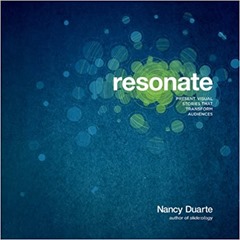 I picked up Resonate: Present Visual Stories That Transform Audiences by Nancy Duarte following a couple of recommendations in Storytelling with Data by Cole Nussbaumer Knaflic. You can see how Resonate influenced the storytelling elements of Knaflic’s book.
I picked up Resonate: Present Visual Stories That Transform Audiences by Nancy Duarte following a couple of recommendations in Storytelling with Data by Cole Nussbaumer Knaflic. You can see how Resonate influenced the storytelling elements of Knaflic’s book.
Resonate is about the importance of storytelling in making presentations, and a model to construct compelling presentations which will leave your audience primed to go off and take the action you want.
The book is beautifully produced, as you might expect from an author from a company which provides consulting on making presentations. In the front material Duarte mentions VisualStory(tm) and Presentation Form(tm) which are products from her company but through the rest of the book Duarte Design is scarcely mentioned.
The nine chapter titles make a pretty good summary of the book, I have added my own comments to clarify a bit:
- Why resonate? – audiences change when you make a personal connection with them, a presentation is not just about facts.
- Lessons from myths and movies – adding elements of storytelling makes a presentation much more impactful – people have been writing about the mechanics of storytelling for a couple of thousand years!
- Get to know the hero – the hero is the audience. In scriptwriting terms the hero goes on a well-defined journey and we are going to take the audience on a similarly structured journey. We tend to write presentation centred on ourselves, our companies and our products – they should be centred on the audience.
- Define the journey – you need to be clear about the intended outcome of your presentation, and make everything in your presentation about reaching that outcome.
- Create meaningful content – this is about compiling the content for your presentation, it includes a call to include personal stories and also to research your audience.
- Structure reveals insights – this is about structuring the content you’ve compiled. A lot of the structure of a presentation is about alternating between “what is” and “what could be”.
- Deliver something they’ll always remember – providing contrasts in presentational style and content to maintain interest.
- There is always room to improve – this chapter emphasises how much work successful presenters put into their presentation, both in initial preparation but also reflecting on performances.
- Change your world – this is largely a call to action for us to go out and do it!
There’s a final chapter called Inspiration is everywhere which has case studies on Mozart – how the sonata structure reflects a presentation structure, Alfred Hitchcock – how a presentation (or a film) is a well-planned collaborative endeavour and e.e. cummings – breaking the rules to get impact. There are a plenty of case studies spread through the book demonstrating how speakers structure compelling presentations, analysing them in terms of the model Duarte proposes. I liked the fact that the case studies included “people like me”, Richard Feynman – a physicist, and Marcus Covert – a biologist.
We’ve all heard of “this meeting could have been an email”, Duarte mentions at one point “this presentation could have been a report”. She sees a presentation as a platform to provoke action, produce change and a raw presentation of facts does not fit this definition – this could be a written report. I find a lot of the presentations I give fall into this category.
Resonate talks mainly in terms of high importance presentations: end of year reports to investors, presentations to win multi-million dollar research grants, Steve Jobs iphone presentation – big productions involving significant work, and a team of collaborators. It is up to the reader to determine how to make these ideas work for their own more modest circumstances.
I was also pleased that some elements that I include instinctively such as personal stories, and passion, and doing some research on my potential audience are recommended and effective. I think my change on reading Resonate will be more focus on The Big Idea and what I want the audience to do when they leave the presentation. There is also a strong indication that my slides should contain less text then I add – Duarte says that a single slide filled with text would take an audience 30 seconds to read, and they will either be reading your slide or listening to you, not both. She also says as a rule of thumb a slide should not be on screen for more than 2 minutes.
Overall, I’m glad I read this book – at times I found the style a bit grating but the content is thought-provoking. As a physical scientist I’m used to the idea that physical models are correct and can be proved. Duarte’s model of how to build and deliver a successful presentation is not a physical model – it is a framework for discussion and a source for new ideas.

